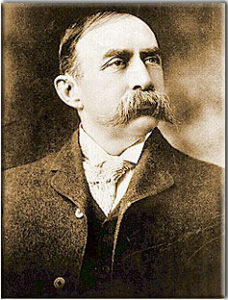John Barclay Armstrong
1850 - 1913

John B. Armstrong, Texas Ranger
John B. Armstrong was born January 1850 in McMinnville, Tennessee. After having spent time in Missouri and Arkansas, Armstrong moved to Texas in 1871 and settled in Austin.
In the early 1870s, Armstrong was a member of the Travis Rifles. On May 20, 1875, he enlisted in the Texas Rangers, becoming a member of Capt. Leander McNelly's Special Forces. He was soon made Sergeant, and took part in the Las Cuevas War. He was also involved in the killing and capture of several suspected criminals in the area between Eagle Pass and Laredo.
After McNelly retired from the Ranger service, Armstrong continued to serve under Lee Hall working in the Eagle Pass area. Armstrong's most famous exploit was his capture of John Wesley Hardin. It was Hardin's killing of Comanche County Deputy Sheriff Charles Webb in May 1874, that put the Rangers on his trail. Captured in Louisiana in September 1874 and returned to Texas, Hardin soon escaped and remained out of sight until August 1877.
Recuperating from a gunshot wound, and walking with a cane, Armstrong still applied to the Adjutant General for permission to work the Hardin case. Detective John Duncan was assigned to work with him. Learning of Hardin's whereabouts in Alabama, Armstrong got a warrant for him, and with Duncan went in pursuit. Hardin's gang had been menacing the railroad and the railroad was happy to assist the Ranger in way possible to capture the outlaw. Tracking Hardin to Florida, the Ranger enlisted the aid of local lawmen in Pensacola to assist them in the capture.
When the train carrying Hardin came into the station, Armstrong entered the front of the coach. Switching his cane to his left hand, he drew his Colt .45 with his right and confronted Hardin and four members of his gang. One of the men drew and shot at Armstrong who returned the fire killing the man. Hardin's gun had hung up on his suspenders allowing the Ranger time to hit Hardin over the head, knocking him unconscious. He unarmed the other three men. Returning to Alabama, Armstrong awaited extradition papers and returned Hardin to Texas.
In 1882 he established a cattle ranch in Willacy county. He died 1 May, 1913, and is buried in Austin at the Oakwood Cemetery.
Suggestions for further reading:
- Chuck Parsons, John B. Armstrong, Texas Ranger and Pioneer Ranchman, College Station, Texas A & M University, 2007
- Walter Prescott Webb, The Texas Rangers, Boston, 1935
- Fred Wilkins, The Law Comes to Texas, Austin, 1999
- James B. Gillett, Six Years With the Texas Rangers, Austin, 1921
- Darren L. Ivey, The Ranger Ideal Volume 2: Texas Rangers in the Hall of Fame, 1874 – 1930, Denton, 2018
- Dora Neill Raymond, Captain Lee Hall, Norman, 1940
